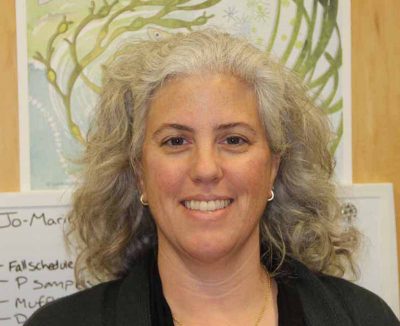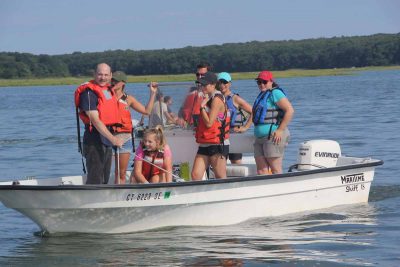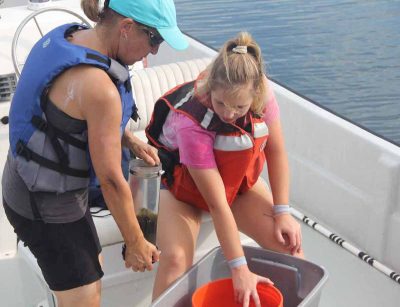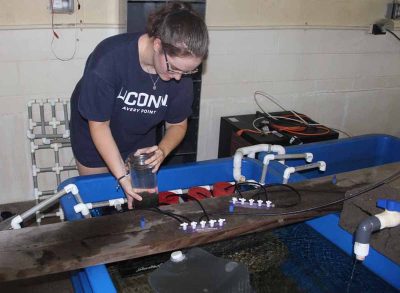
Story and photos by Judy Benson
Popular for boating, fishing and swimming, Little Narragansett Bay has been plagued in recent years by a nuisance green algae, Cladophora, that spreads across the sea floor in blankets up to three feet thick in some areas, virtually smothering out all other life except for tiny marine insects called isopods.
The Cladophora monoculture in the bay has vexed residents of Stonington, Conn., and neighboring Westerly, R.I., for more than a decade, fouling beaches with piles of smelly, decaying seaweed that wash up in the summer. For much of that time, Prof. Jamie Vaudrey and her colleagues in the UConn Marine Sciences Department have undertaken research to diagnose and find a solution to the problem, starting with mapping the locations of the Cladophora.
“The residents want a quick solution, but unfortunately it’s not going to be a quick solution,” Vaudrey said.
Now, in the latest phase of that research, Vaudrey is working with Prof. Julie Granger on a project to pinpoint the source of the nitrogen-laden nutrients getting into the bay that are fueling the explosive seaweed growth.
“This project gets at the processes that are allowing it to grow,” said Vaudrey.

Supported by Connecticut Sea Grant funding, the research involves analysis of water, seaweed and sediment samples from throughout the bay to identify where the nutrients are coming from. Using nitrogen isotopes as chemical fingerprints to match nutrient sources, the work is determining how much of the nutrients are coming from the discharges of the two municipal wastewater treatment plants that empty into the Pawcatuck River – the main freshwater input for the bay – versus other

main sources. Ultimately, the project will quantify nutrients coming from the treatment plants, the
atmosphere – carried by rain and snowfall – and runoff from farms, lawns and pavement.
Through this work, combined with earlier research, a picture is emerging of a waterway being impacted by multiple forces, Vaudrey said. Even though the wastewater treatment plants are doing a better job of removing nitrogen than before recent upgrades, the nutrient load getting into the bay is still too high because of changing conditions there, she said.
“It’s being compounded by warmer waters that’s allowing the seaweed to overwinter, so it starts growing in the summer into larger mats,” Vaudrey said. In addition, natural shifting of the Sandy Point sandbar has restricted tidal flows into the bay, further fueling the algae growth.

The sample collection and analysis and other phases of the project will continue at least through 2020, with students sharing their findings along the way with CUSH, or Clean Up Sound and Harbors, a citizen-science group. Vaudrey expects the results will point to a need to further upgrade the wastewater plants, or refit them so they discharge outside the bay. Another solution may be to harvest the seaweed regularly and compost it on land.
“The solutions are obvious, but they’re expensive,” she said.
Understanding the Cladophora problem in Little Narragansett Bay, she said, could help other communities where the nuisance algae is starting to spread – including in the waters of nearby Mystic and Groton.
A research professor, Vaudrey said she enjoys the challenge of taking on real-world problems.
“I tend to focus on things that are very applicable,” she said. “I like to create tools that are useful to managers and citizens. I like the opportunity to find out things that can be immediately useful to people.”
Judy Benson is the communications coordinator for Connecticut Sea Grant.